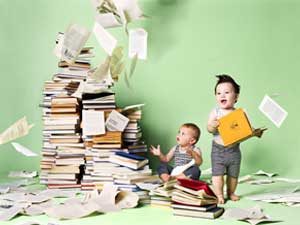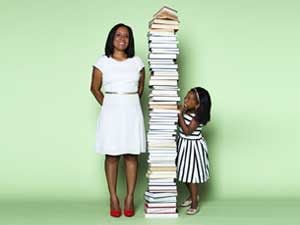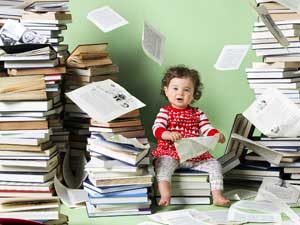What Do All Babies Need, Yet Aren’t Getting Equally?
Updated: May 09, 2023
To break the cycle of poverty, young children need something that’s as free and abundant as air. An extraordinary program is giving it to them.

Babies need a few basic things to get started: mother’s milk, or something like it; love, attention, and playtime; clean clothes; and a safe place to sleep. All over the world, high- or low-income, desert or forest, high-rise or countryside, doting parents give their babies these essentials. But educational researchers have uncovered something else babies need, and this they’re not getting equally up and down the income scale. The missing element is not an heirloom-quality cherrywood changing table, an all-leather car seat with cup holder, or an ergonomic Scandinavian stroller (none of which has been linked to positive life outcomes anyway). The missing element costs nothing and is as plentiful as air, yet the devastating lack of it hampers brain development.
Many low-income American children are suffering from a shortage of words—songs, nursery rhymes, storybooks, chitchat, everyday stuff. How can that be? All parents issue directives—“Time for your bath” or “Let’s put on your jammies.” In low-income families, where parents often have had less education and limited access to parenting guidance, that’s usually the end of it; while in wealthier families, directives are only a small part of an ongoing conversation. “Let’s put on your jammies. Your jammies are so soft! What color are these jammies? They’re yellow. And look at these little animals on your jammies. What are those? Those are ducks! ‘Quack, quack, quack,’ say the ducks!” All that babbling isn’t silliness; it’s mind- building. Words streaming from radio or television, or from parents or caregivers chatting on cell phones, are of no benefit, however—a finding that merits attention from all parents.
In many low-income families, warm and loving parents may struggle desperately to provide all the other basics, without a clue that their relative silence—and the lack of bedtime stories, picture books, and lullabies—hurts the babies.
Beginning in the 1990s, researchers at Rice and Columbia Universities reported eye-opening findings about how many more words middle-class and affluent kids hear day in and out. Using interview techniques and tracking devices including “word pedometers,” they’ve determined that well-off children hear 30 million more words in the first three years of life.
The deficit has astounding and bitter consequences. More than any other strand in the lives of poor children, the 30-million-word gap has been linked to poor school performance, a failure to learn to read, a failure to graduate from high school, and an inability to prepare for and to enjoy career success.

Tammy Edwards, 31, grew up on the South Shore of Long Island, on the Poospatuck Reservation, a shady village of about 100 families affiliated with the Unkechaug Nation. It’s a windy beach town, the asphalt roads and scruffy grass yards giving way to sand dunes and parcels of tangled coastal forest. Massive maple and pine trees rustle with sea breezes. In summer, it looks like a vacation town, full of barefoot kids with Popsicles and folks relaxing on their porches. But it’s also a poor town, with high unemployment; more than a quarter of the households are below the poverty line. Out-of-work men linger in the streets. Smoke shops dominate the retail scene, most operating out of trailers, and some men—in desperation—freelance, flagging down cars to sell individual packs of cigarettes. Four or five families anchor their mobile homes on the same half acre of land and hang up their laundry and raise their children together in the common yard.
Tammy Edwards is a kind and serious young woman who works two jobs while caring for her aging father and young daughter in her mobile home. When exhausted, she might take a moment to smooth back her thick hair and secure it with bobby pins, maybe glancing out the window and quickly tallying how many tasks lie ahead before nightfall. When a bit of humor comes her way, for instance when watching her five-year-old, Ayanah, dance, Edwards’s face lights up with an enormous, disbelieving, happy smile.
She’s used to being on her own. “My mother died when I was 11, and my father couldn’t really take care of me,” she says. She grew up moving from house to house on the reservation, where everyone calls everyone else Cousin; in fact, her grandfather was a chief. “The Unkechaug Nation is my family,” she says.
But though Tammy grew up feeling loved, she, like millions of young Americans, heard too few words. “We didn’t have many books,” she says. “They had a Christmas program for the kids on the reservation, and one year, I won a set of encyclopedias. I was so happy! It felt like winning a whole bunch of money. Afterward, folks would come to me to ask if they could borrow one to do a project. I was happy to share. I graduated high school and got a certificate in medical billing and a certification in home health care. I took a little bit of college, but my grades weren’t too good. I had thought about becoming a teacher.”
Edwards has big dreams for Ayanah, an ebullient girl whose Native American name is Bright Star. And she is lucky because help was nearby.
“At 18 months, every child still has the potential to invent Facebook,” says Sarah E. Walzer, chief executive officer of an extraordinary nonprofit called the Parent-Child Home Program (PCHP). A former legal counsel in the U.S. Department of Health and Human Services, Walzer is a slight, fast-talking woman in her early 50s, with flyaway graying brown hair and a gentle smile. She has devoted her career to trying to level the playing field for poor children.
In the PCHP program, she explains, literacy specialists make home visits to help parents and very young toddlers close the word gap—because by the time a child enters school, it may be too late to catch up.
“Here’s a child on his first day of kindergarten,” Walzer says. “His teacher tells the class, ‘You can pick out a book from the shelf and take it back to your seat.’ But this child has never held a book before. He doesn’t know how to handle it, how to turn the pages. He doesn’t know how to get pleasure from it. He’s failing his first day of kindergarten.”
From there it gets worse. “The data show that a child who is behind in kindergarten will be behind in third grade, behind in sixth grade, and at high risk of not completing high school,” she says.
To address the lag, some states mandated pre-K for four-year-olds. But the low-income four-year-olds were ill-equipped for pre-K too. Federally funded programs like Head Start reached out to children as young as three, but—to the alarm of experts—even the three-year-olds were behind national standards.
Today, it’s widely accepted that the best time to start engaging in verbal interaction—to share rhymes and songs and picture books—is at a child’s birth. The American Academy of Pediatrics recently stated that advocacy for early reading would become part of all well-baby checkups.
“Our job is to get there before the word gap magnifies,” Walzer says. To put parents at ease, the early-literacy specialists often come from the communities in which they’re working, and 25 percent of them are parent-graduates of the program. They visit up to twice a week for two years, with the idea of having fun together, using not only the books, puzzles, and toys provided by the program but also everything available. A visitor will demonstrate how to make sorting laundry a learning experience and how a trip to the grocery isn’t really complete without naming fruits and vegetables, shapes and colors.
It’s a simple strategy, and it works: “Children who go through our program graduate from high school at rates 20 percent higher than those of their national peer group,” Walzer says. Currently the Parent-Child Home Program serves 7,000 families in 12 states. New York, where Tammy Edwards lives, is one of them.
In 2010, Helen Fechter, a PCHP specialist who works within Edwards’s school district, reached out to Tammy Edwards personally. One of Fechter’s first contacts on the Poospatuck Reservation, Edwards had never heard of the program—nor of the importance of early language enrichment—but she was open to learning more.
“Helen told me that introducing a child to reading at 18 months will help them going into school,” Edwards says. “I had ordered a set of picture books for Ayanah but never took the time out to actually sit down with her. I was really happy to have to set a date to do it.”
Edwards’s experience confirms another of Walzer’s observations: “The half hour the visitor spends with a parent and young child is a refuge. The visitor relays, ‘No matter what the house looks like, no matter what’s going on with the rest of your life, let’s enjoy this time of reading and playing with your beautiful child.’”
Edwards soon learned that her basic reading skills were more than adequate to meet her daughter’s needs. “We have clients who cannot read at all,” Walzer says. “We assure them that their knowledge of the world will enrich their child’s experience. You can spend half an hour on two pages of a picture book, enjoying all the details. You can make up the story.”
“Ayanah’s first book was Clifford the Big Red Dog,” Edwards says. “Oh my goodness, she loved that dog! She was 18 months old and had a favorite book. She still talks about that book. She’s in Head Start now and doing really well. She loves all books so much! If she sees a book she feels like reading, like the Dora the Explorer books, she just picks it up.”
“I like Dora!” Ayanah agrees. “And Diego. Diego is Dora’s cousin. Dora is a big girl like me. I like the Frozen book. I like books about frogs. I like books about the ones that have long necks, named giraffes. Also horses. Chickens. And birds. I like books about birds.”
As Tammy Edwards began referring friends on the reservation to PCHP, more and more parents opened their doors. Helen Fechter became such a regular at Poospatuck that, today, as she drives through the village, everyone waves. “I feel like a celebrity,” Fechter says.
To date, 23 families have participated in PCHP as a result of Edwards’s endorsement. And when Ayanah graduated from the program, Edwards went through training to become an early-literacy specialist herself.
In November 2012, PCHP named her a Parent Literacy Champion and gave her a $1,000 scholarship. Edwards plans to go back to school to earn her teaching certification.
Recently, Edwards visited with two-and-a-half-year-old Jailah Overton and Jailah’s mother, Shavon, to introduce a new book. Jailah was all dressed up in a gray-and-pink top, her round clean face glowed, and her hair had been tightly woven and braided with little white beads. Her mother couldn’t stop smiling with pride and excitement as she sat down with her daughter for their lesson. Ayanah, now five, tagged along to help and chose one of her favorite books to share: Are You My Mother? by P. D. Eastman.
Jailah listened intensely as Edwards read the classic plight of the baby bird who hatches while his mother is off hunting for food. Off he treks in search of her, asking a dog, a kitten, a hen, a cow, and a steam shovel if any of them is his mother. Jailah looked captivated, probably as awed by the importance of this momentous half hour as by the page-turning plot.
“ ‘Are you my mother?’ he said to the cow,” read Edwards. “ ‘How could I be your mother?’ said the cow. ‘I am a cow.’ ” A little worried, Jailah glanced at her own mother for reassurance.
Suddenly Ayanah intervened, feeling she could do a better job of holding the book and turning the pages. Edwards smiled and read on.
“Just then, the mother came back to the tree!” she read with excitement.
“She came back!” echoed Jailah’s mother. Jailah scrunched up her little face in glee.
“Look, who is that?” asked Edwards, drawing Jailah back to the book.
“That’s the mommy bird—that’s her mommy!” explained Ayanah.
“ ‘Yes, I know who you are,’ said the baby bird,” read Edwards. Jailah gazed up into the faces of Edwards, Ayanah, and her mother and then back to the page, taking in all the great news. “ ‘You are my mother!’ ”
At this, Jailah, overcome, collapsed sideways into her mother’s lap.

At the end of the two-year program, Walzer says, some parents grow anxious. A parent will say to a home visitor, “I don’t mind if you don’t bring any more books or puzzles, but can you please keep coming?” The visitor will say, “We still have some time left, but you need to know that you have done all of this, not me; you are the one who has been educating your child.”
“Pretty early on,” Walzer says, “usually within the first week or two, when the child comes out with a new word or completes a rhyme, a parent will say, ‘I had no idea my child could be so smart.’ That’s the moment that changes the whole trajectory because when parents have high expectations, their children tend to succeed. The parent starts saying, ‘You are so smart, you’re going to graduate from high school. You are going to college.’ ”
ABOUT OUR PARTNERSHIP
The Reader’s Digest Foundation is proud to announce a two-year $500,000 grant to the Parent-Child Home Program that will kick off a national partnership to celebrate reading and improve children’s literacy.
MORE FROM THE PARENT-CHILD HOME PROGRAM
The Parent-Child Home Program is a proven early literacy, parenting, and school readiness model, that works one-on-one with families to help them discover the importance of reading and playing with their children while providing the skills and materials they need to prepare their children for school and life success. We are proud to partner with Reader’s Digest on the READ Together initiative. Please visit our website for recommendations on our favorite pre-school books and toys as well tip sheets filled with ways you can use the materials to build school readiness, spark conversations with your child, and expand upon the book with other literacy and numeracy activities.